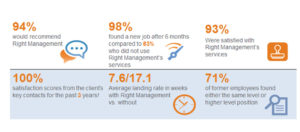As we assess the global jobs market more than one year since the start of the COVID-19 pandemic, it is clear the environment is in flux. Over the next five years, 43% of businesses expect to reduce the size of their workforce, yet, over the same period, 34% of businesses plan to expand their workforce.1 With increased digitization and automation across industries, more and more companies are either planning for, or are in the midst of major transformations.
An organizational transformation impacts the entire workforce. It affects those leaving due to redundancy, the managers who must deliver the difficult news, and the remaining employees. Most know that exiting employees benefit when a company provides outplacement services. It takes a jobseeker at least 23 weeks to land a new role on average in the U.S.,2 but this gap shrinks significantly when career transition services are used. Lesser known and discussed is how outplacement also fosters confidence and morale among the employees who remain.
Here are three ways outplacement will help you support your entire workforce during and after organizational transformation.
Pilot a smooth landing for exiting employees
Did you know it’s more difficult for a commercial jet pilot to make a smooth landing when the aircraft is empty?3 The same can be said about an employee exiting a job with no outplacement assistance, especially as unemployment rises and more support is needed to find open positions. According to Kaye Owen of Lloyds Banking Group, workers who are currently facing redundancy seem to be in a much higher emotional state of stress due to the global pandemic and its aftershocks.4 Outplacement alleviates some of this stress by helping those leaving the organization do so with confidence and positivity.
This confidence comes from an outplacement provider’s ability to help workers find new roles more quickly. Artificial intelligence and machine learning are rapidly evolving in the outplacement space to help exiting employees land on their feet more quickly. Right Management, for example, leverages specialized experts to prepare workers in transition for their next steps. Those who are “matched” to expert career coaches.5
Using outplacement services to pilot a smoother landing for exiting employees shows your company cares about its employees’ mental health and future success. Helping workers prepare for what’s next also maintains positive relationships should your organization need to re-hire these individuals in the future.
Motivate remaining employees to stay put
“What happens with the remaining employees?” should be one of the questions you ask before executing an organizational transformation. During and after a transformation, the employees who remain often experience ‘survivors’ guilt,’ or lack of motivation and engagement due to ongoing uncertainty, burnout from taking on more work, and/or anxiety that their jobs are in danger too. These stressors often push workers to leave the organization. In fact, a 1% decrease in the size of your workforce can lead to a 31% increase in turnover the following year.6
Demonstrating outplacement support, providing situational coaching, and talking about the changes in an open manner encourages trust among the remaining workforce. The jewelry company Pandora attributes the success of its recent transformation to simplifying its overarching goal to one core KPI—like-for-like sales—so that it was easily understood and remembered by all employees. Pandora made sure remaining employees had opportunities to connect to the organization’s new strategy and objectives through internal town hall meetings and weekly emails during the transformation.7 Asking for the entire workforce’s buy in opens the door to moving forward positively throughout the transformation and after it is complete.
Coach leaders and managers to communicate better
Communicating difficult messages is no easy feat, especially for line managers who may not be used to the responsibility. As part of an outplacement program, look to support managers and leaders in delivering consistent and fair communication across all levels of employees.
Right Management has been the outplacement partner to a major retailer for over 11 years. To support the retailer through multiple downsizes, training was provided to the leaders and managers who would deliver the notification message to affected employees. By sharing best practices on how to communicate the changes, the retailer mitigated legal risk while also offering invaluable support to its managers and leadership team.
Transparency and steady communication are key to a successful transformation, and it’s important to think about the lasting impact on the entire workforce. Providing adequate support now will mean a more engaged and productive workforce once the transformation is over and lower your organization’s risk of losing top talent in the future.
For the full story, download our latest white paper, Careers In Transition: How will outplacement evolve to help companies and workers respond to upheaval?
1 https://www3.weforum.org/docs/WEF_Future_of_Jobs_2020.pdf
2 https://www.bls.gov/news.release/empsit.t12.htm
3 https://www.boldmethod.com/learn-to-fly/aerodynamics/why-its-hard-to-land-smooth-in-empty-jets/
4 ManpowerGroup Careers in Transition: How will Outplacement Evolve to Help Companies and Workers Respond to Upheaval? Whitepaper, 2021
6 https://hbr.org/2018/05/layoffs-that-dont-break-your-company
7 https://www.bcg.com/en-us/publications/2020/four-phases-and-three-journeys-of-successful-transformation





